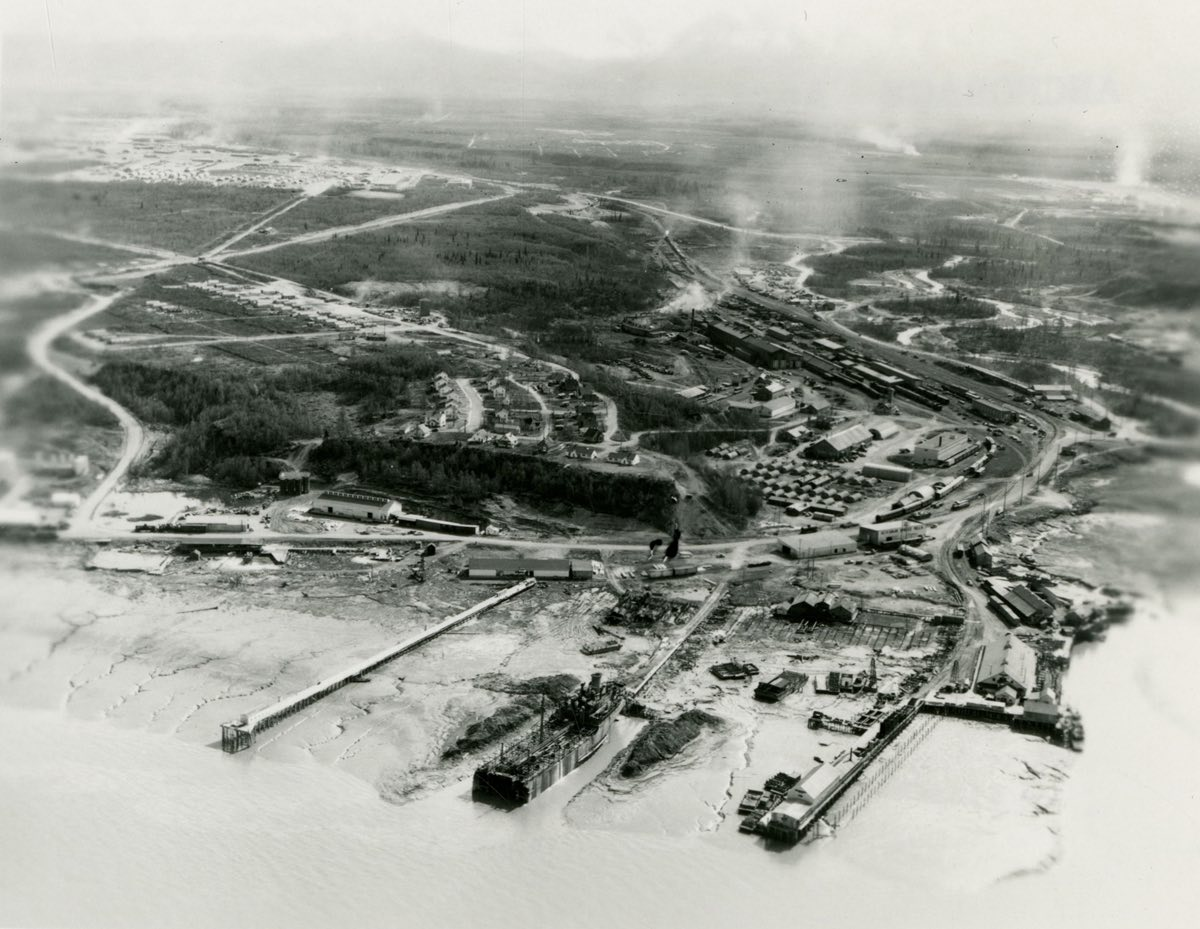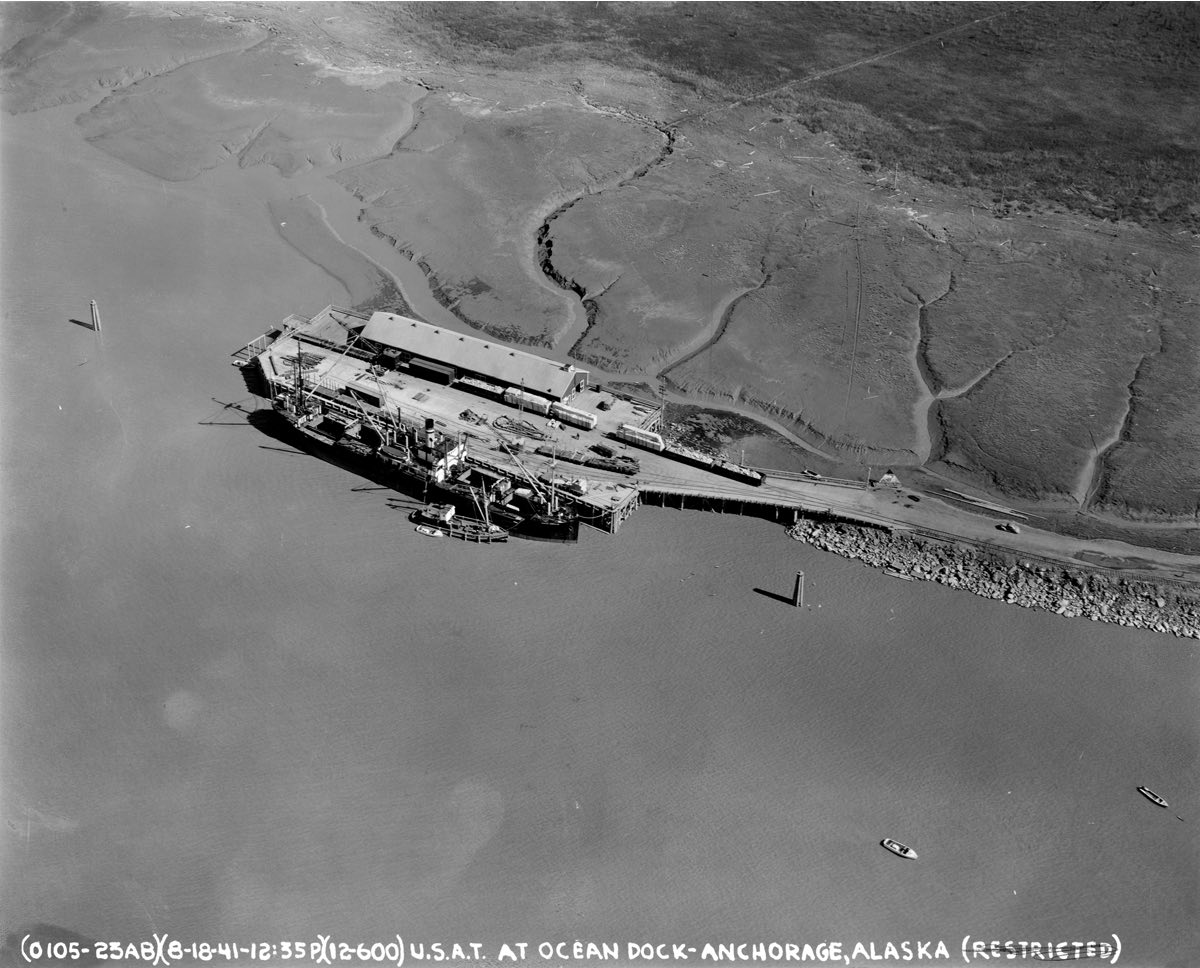
Here is the first photo, taken looking almost due East off shore at the mouth of Ship Creek. At the top left is Fort Richardson Army Air Field. It did not become Elmendorf AFB until 1948. At the top far right is Merrill Field and the Martin Dairy Farm.
Ship Creek meanders through the center right of the wooded area along the South side of the Anchorage Yard.
In the center of the photo is Government Hill housing with two story row duplex houses built for government contract workers with the CAA, Weather Bureau and other Government agencies during WWII. Along the bluff are private and ARR cottages. Most of these structures are still private homes today. The US ARMY Signal Corp built a complex with three radio towers right in the middle of the residential area and provided radio and radio telephone communications from the very earliest days of the Railroad. The buildings still stand.
Beyond structures on Government Hill I can make out only two buildings that exist today. There is a large smoke stack rising from a large concrete building with few windows, just above right of center in a cloud of steam. That is the Alaska Railroad Power House built of concrete about 1922 after the first one burned to the ground. Just to its left is the only photo record of the North portion of the Anchorage Round House which burned early on leaving only the East portion. The large flat roof two story rectangular structure was part of the stores department and commissary. That building stands today in rather poor condition, just across a bisecting RR spur behind the current Stores Department. All other structures in this photo are gone as of 2022 as far as I can recall.
Just above the Commissary, an extension of C street came down off the hill from Anchorage, crossed the RR Yard and up Government Hill through Fort Richardson on the Davis Highway, on its way to Eagle River, Eklutna, Palmer and the Glenn Highway to the ALCAN. Other structures of note are the many Quonset huts which housed the 1400 men of the 714th Railway Operating Battalion which ran the Alaska Railroad during WWII. In the center of the complex are the laundry, showers and rest rooms and at the bottom edge of the compound was the mess hall and administration offices.
Just South of the 714th compound, across the road and tracks was Ketchikan Spruce Mills servicing customers from the complex of buildings on both sides of the street. Conveniently at water side were the ship ways where the Alaska Engineering Commission (AEC) built many of the river tunnel boats and barges used during original construction and then to support the war effort.
Starting at the South (right side) of the water front is the EMARD Cannery complex which processed the salmon catch for most of upper cook inlet above Kenai. The long finger pier with the warehouse was the original AEC dock from 1917. Next comes the boat yard where barges and tunnel boats were pulled out of the water in the winter time.
In the center at the bottom of the photograph is a real story. That is just what it looks like, half of an ocean going tanker. The SS Sackett Harbor saga is documented here and here. If you look carefully in the zoom mode you will see the high voltage overhead line crossing Ship Creek on it's way to power up Anchorage. The Sackett Harbor served until the new Church Electric Association COOP built the Ship Creek power station that was eventually decommissioned and then refurbished by Central Environmental Companies as the SHIP CREEK INDUSTRIAL COMPLEX. The old becomes new again! -- Related by Patrick Durand May 21, 2022

U.S.A.T. AT OCEAN DOCK ANCHORAGE 9/8/41
United States Army Transport is unloading next to the Alaska Railroad Ocean Dock at mid tide about noon, based on shadows. The date is approximated as September 8, 1941 as indicated by note at the top “Record 9/8/41 from Ft. Richardson, Alaska.” From late November to April the flow ice in Cook Inlet diverted all freighters to Seward and later, Whittier which remained ice free.
Ocean Dock construction started in 1918, at the end of a causeway built by the ARR out to the edge of the mud flats where tidal currents in the inlet helped maintain a channel. Page 227 of Alaska Railroad by Prince shows the start of the “Coal Dock Site” with pile driven out to the water's edge. On page 229 and 309 you can see displacement ballast being applied to create the causeway. On page 315 The Admiral Watson was tied up to the new dock but the first arrival was made by the S.S. Anyox on September 16, 1919. The dock was only kept serviceable by regular dredging. This location today is surrounded by the modern “Port of Alaska” nee the Port of Anchorage.
With the hold hatches open, it appears that unloading is near complete. At the bow you can see the hull bottom paint is exposed. The ship's own lift booms probably did most of the work requiring a number of longshoremen on the dock. There are at least 8 individuals you can pick out on the dock. Also available is a crawler crane and the old long stick steam locomotive crane next to the freight house.
The name of the ship is not legible and the color bands on the stack are not in color so we just have to take the notation on the photo that this is in fact, a United States Army Transport circa 1941. Alaska was already preparing for an expected conflict with Japan, putting major stress on available transportation services.
The smaller costal freighter, estimated at 90 feet, is typical of boats serving costal Alaska, often moving barges with freight, fuel and passengers. Tied up next in line is one of two nice looking inboard, open cockpit boats in the image. Are these new 1941 military assets at the port? -- Related by Patrick Durand May 30, 2022
Click here for the other images.

